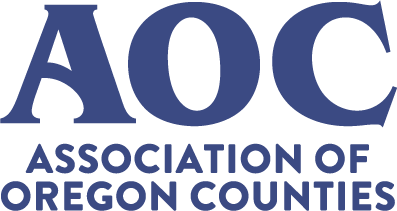
Jun 15, 2023 | AOC News
The mission of the Housing Stability Council is to provide leadership in, and review and set policy for, the development and financing of affordable housing throughout the state of Oregon.
The nine-member council meets monthly and additionally as needed to:
- Help establish strategic direction and a policy framework for OHCS.
- Set policy for and issue decisions regarding loans, grants, and funding awards.
- Help the director foster constructive partnerships with other state agencies and key partners engaged in housing and community services, and more.
Click here to view the Scouncil’s charter for a complete understanding of the Housing Stability Council’s duties.
Interested individuals can learn more and apply online before June 30.
Contributed by: Jessica Pratt, AOC legislative affairs manager

Jun 14, 2023 | AOC News, Member Services
The Association of Oregon Counties (AOC) Membership Committee is excited to announce that applications are now open for the 2023-2024 AOC Membership Exchange Program.
The application process includes a quick, five-minute survey to help identify which counties you are interested in learning more about and what you hope to share about your county with your colleagues.
Based on the application information, applicants will be placed in pairs or small groups and encouraged to plan county visits to get on the ground exposure to county successes, projects, and programs across diverse geographic regions and county structures.
Introduced in 2021 by the AOC Membership Committee, the AOC Membership Exchange Program was created to support AOC’s purpose to unite and advance county issues, foster trust in county government, and develop programs and services that support the success of counties into the future. Since inception, over 20 participants representing 16 counties, have planned exchange visits across the state.
Learn more about the program timeline and apply today on the program’s webpage. The applications portal will close on Friday, July 7 at 12:00 midnight PDT.
Contributed by Kristen Paul, AOC public affairs associate

Jun 14, 2023 | AOC Advocacy, AOC News, Natural Resources
The Association of Oregon Counties (AOC) has continuously engaged with the legislature, state agencies, and stakeholders in the development of comprehensive wildfire policies for numerous sessions. By focusing on thoughtful, effective, and regionally tailored wildfire policy, AOC has been able to ensure the county perspective is not only at the negotiating table but included in the implementation of statewide policy on wildfire.
Senate Bill 80B (2023) makes many technical changes to the 2021 Wildfire bill, SB 762, including revisiting the statewide wildfire risk map. Based on AOC Natural Resources Steering Committee principles and discussions, AOC staff and steering committee chairs worked with bill sponsor Senator Jeff Golden (D-Ashland), the Oregon Department of Forestry (ODF), and Wildfire Program Advisory Council Chair Mark Bennett and Director Doug Grafe on statutory changes with the goal of an improved statewide wildfire hazard map.
Upon passage of SB 80, statute now requires that, “to ensure local characteristics in each area of this state are considered in the mapping process and before the draft map is released, the department shall meet with county commissioners and their staff in eight in-person meetings throughout this state.”
The bill goes on to say that after those meetings occur and the map is released for public comment, counties will have one additional opportunity to meet with ODF to discuss additional concerns and potential changes to the map. This process must be “interactive and does not consist solely of delivering information in a top-down manner.”
Finally, to ensure that counties have an active role in the wildfire mapping process, ODF stated on the legislative record that, “The department will receive and consider all comments and concerns for integration into the map, and if they are not integrated, an explanation on why will be provided.”
These county-ODF meetings will be scheduled in coordination with the AOC District Meetings this fall. AOC staff is meeting with county planning directors in advance of the fall ODF meetings to ensure counties are prepared to engage meaningfully in the map review process.
“We look forward to meeting with county commissioners and staff as we put the Wildfire Hazard Map together later this year,” said Cal Mukumoto, Oregon State Forester. “Through working together with counties we were able to craft language that works for both parties. Knowing the local concerns and issues faced in specific areas will help us make a map that is beneficial statewide.”
Contributed by: Branden Pursinger, AOC legislative affairs manager

Jun 2, 2023 | AOC News
There has been a lot of talk about housing as the Kotek Administration prioritizes solutions to the state’s housing crisis. Project Turnkey, an Association of Oregon Counties (AOC) supported program, is one of several models being deployed to provide targeted solutions tailored to community needs.
Last month, Oregon Governor Tina Kotek joined Polk County Commissioner Jeremy Gordon, AOC Executive Director Gina Firman Nikkel, and community leaders for the ribbon cutting of the Project Turnkey property, ARCHES Lodge in northeast Salem.
ARCHES Inn, a former hotel, was purchased by Mid-Willamette Valley Community Action Agency (MWVCAA) using grant funding from several sources, including $3.5 million from the second tranche of Project Turnkey’s investment from the state. The region has identified veterans and people with acute health needs, including unsheltered people being released from clinics or emergency rooms, as its priority population for shelter and services.
True to the intent of the program, each local community focuses on specific housing and services tailored to the needs of their guests. Some recipients of the funds used the program to uplift community members impacted by wildfire, some for those transitioning following substance use recovery, some for transitional housing for youth, and some for survivors of domestic violence.
Since 2020, the State Legislature has invested close to $125 million in Project Turnkey. In the first tranche of funding, the program added nearly 900 units of shelter for Oregonians in need through the conversion of 19 motel sites in 13 counties around the state. In the second tranche of funding, which is being deployed through June of 2023, it is expected that an additional 500 units of shelter will be created.
“Project Turnkey was really a culmination of the pandemic, wildfire, and general housing crisis in Oregon. And, with my background in mental health, and the work that counties do to support our residents through wraparound services, it was clear that housing was one of the first critical steps in addressing mental health needs for Oregonians,” Nikkel said.
Following that conversation, AOC formed and co-convened a workgroup with the League of Oregon Cities (LOC), inviting legislators and other housing stakeholders to the table to identify how to achieve solutions that best served Oregonians. Oregon Community Foundation (OCF) staff engaged in the convening and feasibility study of the model. Ultimately, OCF served as fiduciary and grant administrator for the implementation of the program. This group worked closely with Kotek, who, at the time, served as Speaker of the House, for the initial investment in the program.
Nikkel is grateful for the governor’s engagement with the program. “Governor Kotek was a strong advocate for the program in her tenure as Speaker of the House and now as governor. She continues to be a strong partner for counties.”
With the strong success in the first phase of the program, Project Turnkey saw an infusion of $50 million more from the state in 2022. Organizations around the state applied for the opportunity to purchase motels, hotels, and other existing structures and utilize them short-term as shelter or temporary housing. Longer term, the properties may convert to permanent housing as the local housing needs shift and evolve.
OCF, the administrator of Project Turnkey, is continuing its work, guided by a statewide Advisory Committee. The second tranche of $50 million in funding is being awarded to new sites around the state, and in alignment with legislative direction for the funds, all acquisitions will be completed by June 30, 2023.
Eligible property types include hotels, motels, and other vacant properties that can readily and affordably be converted to non-congregate shelter such as duplexes, apartment complexes, care facilities, or dormitories.
Nikkel serves on the Advisory Committee that reviews Project Turnkey applications and recommends awardees for funding. She said the second tranche of funding brought 32 applications from regions around the state.
“The need for housing is great, and while Project Turnkey is one of several pieces needed to address the housing crisis, it is not the only set of housing we need, Nikkel stated. We need people to move up – from shelter beds to middle housing, and so on.”
There was no direct request for funding for the 2023 Legislative Session, but conversations continue. Nikkel met with Kotek in early April and discussed the success of the program.
As Project Turnkey properties launch in communities around the state, counties are working with community partners to provide wraparound services to program participants. Each site is uniting community partners to offer the right resources to each guest to help them stabilize and move to permanent housing.
AOC, LOC, and partners continue to convene to address future housing solutions. Partners include: CASA of Oregon; Hacienda CDC; Network for Oregon Affordable Housing; Oregon Emergency Management; Oregon Community Foundation, Oregon Health Authority; Oregon Housing and Community Services; Oregon Restaurant and Lodging Association; Oregon Community Foundation; Oregon Housing Stability Council Chair and Lincoln County Commissioner Claire Hall; former Morrow County Commissioner Jim Doherty; State Representative Pam Marsh (D-Ashland); and former State Representative Alissa Keny-Guyer (D-Portland).
Contributed by: Mckenzie Farrell, AOC operations director

Mar 24, 2023 | AOC News
AOC, your membership organization, has been hard at work this last quarter. We’ve been able to navigate some complex policy discussions; build and strengthen partnerships; and officially opened the doors to our new building to celebrate this achievement at our March open house.
While not a full review of our activities, below are some highlights for us as an organization this last quarter.
Legislative Session – Policy
Members and staff have been actively testifying and lobbying legislators on critical issues facing our counties. While we are nearing the end of the first chamber deadlines this session, we have already seen the bill list narrow – as a reminder, long sessions see anywhere from 3,000 – 4,000 bills introduced.
March 17 was the first deadline. By this date, bills that had not been posted for a work session are presumed dead. April 4, is the next deadline. Bills that have not been moved out of a policy committee in their chamber of origin to either the other chamber, or a joint committee will be added to that list, further narrowing bills of focus for the Legislature.
The AOC legislative affairs team has put together the initial list of high-level bills they are tracking, calling out which survived the first deadline and which did not. Click here to view this list.
As a reminder, while we are working hard to move AOC supported bills, it’s not as simple as a bill dying at the deadline. Some policy issues do resurface through “gut and stuffs”, amendments, the budget, new bill introductions, or may be further explored in work groups.
Sine die is the official call of what makes it and what does not, but deadlines help narrow the scope of focus on legislation.
Legislative Session – Budget
In addition to policy discussions, the Legislature is diving deeply into creation of the state’s 2023-25 budget.
Over the next few weeks, the Joint Committee on Ways and Means will be conducting its biennial “road show,” where they will take their budget framework, released March 23, by the powerful budget committee co chairs, and seek feedback from Oregonians.
The committee will visit the following four cities for public input:
- Portland (April 8);
- Newport (April 14);
- Roseburg (April 21); and
- Ontario (April 28).
More information is available here.
AOC would encourage our members to connect with legislators on the committee and provide testimony on key funding for county programs.
If you have any questions please feel free to contact me or any member of our legislative affairs team.
Open House
On March 13, AOC officially opened its doors to members, partners, and stakeholders to celebrate our new building. Our building, purchased in November of 2021, is now equipped with furniture, audio visual equipment, and is well organized to support the needs of our organization, day-to-day operations, members, and any events we may host at the building.
I was delighted to see so many members and partners drop by to see our new space and network.
Partnerships
I am pleased to say AOC is building strong relationships with the governor’s office, her staff, and agency partners. I am meeting with the governor’s office to build relationships and elevate our membership needs. Staff on your legislative affairs team are regularly meeting with the governor’s staff and agency staff to advocate for our issues. This is important work, and a high priority for AOC as a new administration means new staff, new direction, and new opportunities for collaboration.
Looking Forward
We look forward to closing out the legislative session with some wins for our members.
If you have any questions, please feel free to reach out.
Gina Firman Nikkel, Ph.D.
AOC Executive Director

Mar 17, 2023 | AOC News
The Joint Committee on Ways and Means Co Chairs Senator Elizabeth Steiner (D-Beaverton) and Representative Tawna Sanchez (D-Portland) announced a series of public hearings on the state budget in four locations around the state: Portland, Newport, Roseburg, and Ontario.
The public hearings will kick off on April 8 at Portland Community College- Sylvania Campus. Public testimony will be taken from 10 a.m. to 12 p.m.
How to Testify:
Members of the public will be able to access sign up links on the Ways and Means Committee’s webpage to testify. Sign up links will be available online in the next week.
Public Hearing Schedule:
Date: Saturday, April 8
Time: 10 a.m. – 12 p.m. (PDT)
Location: Portland Community College – PAC Auditorium, Sylvania Campus 12000 SW 49th Ave, Portland, OR 97219
Date: Friday, April 14
Time: 5 p.m. – 7 p.m. (PDT)
Location: Newport Performing Arts Center 777 W Olive St, Newport, OR 97365
Date: Friday, April 21
Time: 5 p.m. – 7 p.m. (PDT)
Location: Umpqua Community College 1140 Umpqua College Rd, Roseburg, OR 9747
Date: Friday, April 28
Time: 5 p.m. – 7 p.m. (MTZ)
Location: Four Rivers Cultural Center 676 SW 5th Ave, Ontario, OR 97914
All hearings will be open to the public and members of the press.
To view the original release, click here.
Contributed by: Megan Chuinard | Public Affairs Associate






